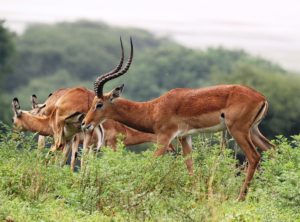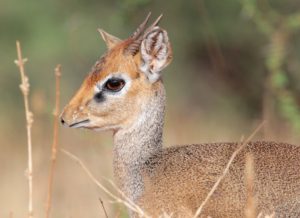To survive, animals must find nutritious food and drinking water—sometimes during long dry seasons or cold periods—and at the same time avoid being eaten. Plant-eating mammals with hooves for feet are an extraordinarily diverse group of animals and are critically important in East African savannas. Yet they must compete more and more with humans for space in a fast-changing world while also evading hungry lions, leopards, and other natural predators. A new study by scientists from the University of Zurich’s PopEcol group and Pennsylvania State University, published in the Journal of Mammalogy, investigated the habitat needs of a community of hooved-mammal species in the Tarangire Ecosystem of northern Tanzania, and how vegetation, water, presence of humans, and risks from predators influenced their use of these habitats.
This was the first study of its kind in the Tarangire Ecosystem, which supports the ecotourism hotspot of Tarangire National Park and is the heart of Maasailand where cattle herders and wildlife have thrived together for centuries. Tarangire differs from other areas where wild ungulates have been intensively studied—like Serengeti National Park or Kruger National Park—in that Tarangire’s wildlife, cattle-keeping people, and farmers all share the landscape, and animals can move unimpeded because the entire region is unfenced.
“Ungulates of different body sizes have different needs and threats,” said the study’s lead author Nicholas James, who conducted the research as a graduate student at University of Zurich. For instance, large ungulates like adult giraffes may have less to fear from natural predators but may face more danger from humans, and smaller animals may have more specialized food requirements. “We wanted to know what features draw each ungulate species to certain areas so we can pinpoint important habitat for each of those species,” James said. This information is important for land managers to maintain thriving populations of wild ungulates and keep the landscape healthy, which is the foundation of Tanzania’s important ecotourism economy.
James and his co-authors counted and mapped six hooved mammal species in dry and rainy seasons over seven years in and around Tarangire National Park and the adjacent Manyara Ranch Conservancy, including unprotected village lands. The ungulates studied included the iconic, massive giraffe down to the little dik-dik—both of which specialize on eating leaves of woody plants—as well as the large, water-loving, grass-eating waterbuck, and three medium-sized antelopes that eat both woody-plant leaves and grass, the impala, Thomson’s gazelle, and Grant’s gazelle. The scientists looked at how the different species used areas depending on the type and greenness of plant food, the thickness of the bushes (where lions often lurk), and how far the areas were from rivers (which provide vital drinking water but also hide predators) and cattle herder settlements (where human disturbance is higher but the humans also keep away predators). The study highlighted the importance of food (vegetation) for all species, as well as nearness to year-round rivers for most but not all. Some species appear to be tolerant of human presence and even congregated close to cattle herder settlements, presumably because of lower predator densities there. The researchers found that antelopes that ate both grass and woody-plant leaves allowed them to avoid areas with high human activity while meeting their dietary needs. Importantly, the presence and number of herbivores were sensitive to short and long-term variation in rainfall suggesting they are vulnerable to drought.
“We show that the focus of research and management should be directed towards the Tarangire Ecosystem’s free-flowing rivers and associated habitat along those rivers,” said Derek Lee, associate research professor at Pennsylvania State University and senior author of the study. “In dry landscapes like East African savannas, water resources are increasingly monopolized by humans, so protection of waterways in human-dominated landscapes, and ensuring sufficient access for wildlife is of primary conservation importance.” Another key finding of the study was that traditional cattle herders and some ungulate species can share the same space and thus appear to be compatible, so long as the human impacts remain relatively low.

